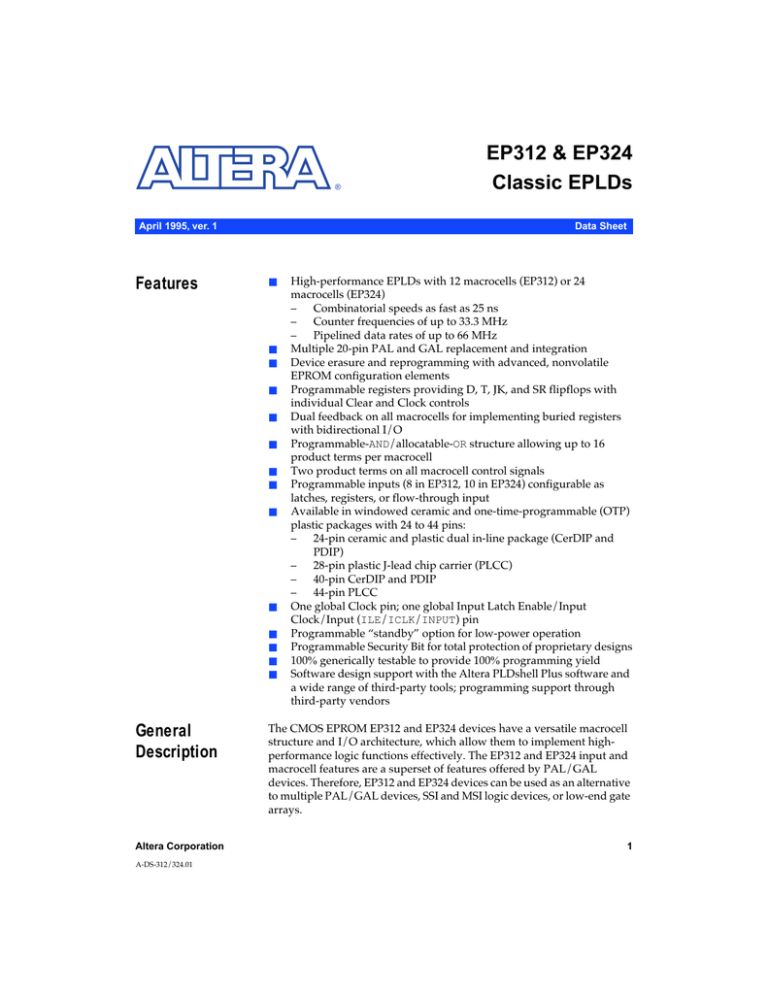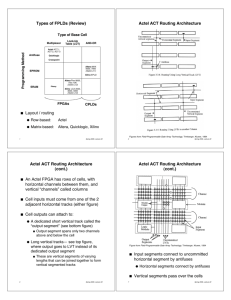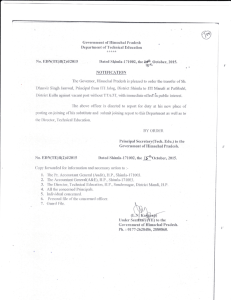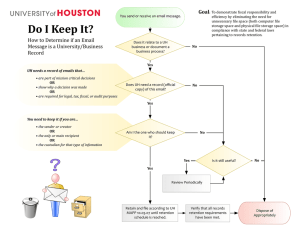
®
April 1995, ver. 1
Features
Data Sheet
■
■
■
■
■
■
■
■
■
■
■
■
■
■
General
Description
Altera Corporation
A-DS-312/324.01
EP312 & EP324
Classic EPLDs
High-performance EPLDs with 12 macrocells (EP312) or 24
macrocells (EP324)
–
Combinatorial speeds as fast as 25 ns
–
Counter frequencies of up to 33.3 MHz
–
Pipelined data rates of up to 66 MHz
Multiple 20-pin PAL and GAL replacement and integration
Device erasure and reprogramming with advanced, nonvolatile
EPROM configuration elements
Programmable registers providing D, T, JK, and SR flipflops with
individual Clear and Clock controls
Dual feedback on all macrocells for implementing buried registers
with bidirectional I/O
Programmable-AND/allocatable-OR structure allowing up to 16
product terms per macrocell
Two product terms on all macrocell control signals
Programmable inputs (8 in EP312, 10 in EP324) configurable as
latches, registers, or flow-through input
Available in windowed ceramic and one-time-programmable (OTP)
plastic packages with 24 to 44 pins:
–
24-pin ceramic and plastic dual in-line package (CerDIP and
PDIP)
–
28-pin plastic J-lead chip carrier (PLCC)
–
40-pin CerDIP and PDIP
–
44-pin PLCC
One global Clock pin; one global Input Latch Enable/Input
Clock/Input (ILE/ICLK/INPUT) pin
Programmable “standby” option for low-power operation
Programmable Security Bit for total protection of proprietary designs
100% generically testable to provide 100% programming yield
Software design support with the Altera PLDshell Plus software and
a wide range of third-party tools; programming support through
third-party vendors
The CMOS EPROM EP312 and EP324 devices have a versatile macrocell
structure and I/O architecture, which allow them to implement highperformance logic functions effectively. The EP312 and EP324 input and
macrocell features are a superset of features offered by PAL/GAL
devices. Therefore, EP312 and EP324 devices can be used as an alternative
to multiple PAL/GAL devices, SSI and MSI logic devices, or low-end gate
arrays.
1
EP312 & EP324 Classic EPLDs
EP312 and EP324 devices operate in high-performance systems with
low power consumption. The programmable standby function
provides “zero” power consumption for applications where
performance can be traded for power savings.
Functional
Description
The EP312 and EP324 architecture is based on a sum-of-products
programmable-AND/allocatable-OR structure. EP312 and EP324
devices can implement combinatorial and sequential logic functions,
as well as combinatorial-register and register-combinatorial-register
logic forms, to easily accommodate state machine designs.
Figure 1 and Figure 2 show block diagrams of the EP312 and EP324
architectures. The EP312 device contains 12 I/O macrocells and 8
programmable input structures; the EP324 device contains 24 I/O
macrocells and 10 programmable input structures. EP312 and EP324
macrocells are divided into 2 rings for product-term allocation. Both
devices have 2 additional inputs that can be programmed either as
combinatorial inputs or Clock inputs. Each input structure can be
individually configured as a latch, register, or flow-through input.
Input latches and registers can be clocked synchronously or
asynchronously.
Figure 1. EP312 Block Diagram
Global Clock
Clock/Input 1
Input/Register/Latch
Macrocell 1
Macrocell 2
Macrocell 3
Macrocell 4
Macrocell 5
Macrocell 6
Input 1
Input 2
Input 3
Input 4
Global
Bus
1
2
3
4
5
6
Ring 1
7
8
9
10
11
12
Ring 2
Global Clock
Input 5
Input 6
Input 7
Input 8
Macrocell 7
Macrocell 8
Macrocell 9
Macrocell 10
Macrocell 11
Macrocell 12
Input Latch
Enable/Input
Clock/Input 2
2
Altera Corporation
EP312 & EP324 Classic EPLDs
Figure 2. EP324 Block Diagram
Input/Register/Latch
Global Clock
Clock/Input 1
Macrocell 1
Macrocell 2
Macrocell 3
Macrocell 4
Macrocell 5
Macrocell 6
Macrocell 7
Macrocell 8
Macrocell 9
Macrocell 10
Macrocell 11
Macrocell 12
Input 1
Input 2
Input 3
Input 4
Input 5
Global
Bus
Input 6
Input 8
Input 9
Input 10
Ring 1
13
14
15
16
17
18
19
20
21
22
23
24
Ring 2
Global Clock
Macrocell 13
Macrocell 14
Macrocell 15
Macrocell 16
Macrocell 17
Macrocell 18
Macrocell 19
Macrocell 20
Macrocell 21
Macrocell 22
Macrocell 23
Macrocell 24
Input 7
1
2
3
4
5
6
7
8
9
10
11
12
Input Latch
Enable/Input
Clock/Input 2
The EP312 and EP324 architectures include the following features:
■
■
■
■
Macrocells
Product-term allocation
Programmable inputs
Power-on characteristics
Macrocells
Each EP312 and EP324 macrocell contains 16 product terms (see Figure 3).
Half of the product terms are available to support logic functions; half are
dedicated to the macrocell control signals. The inputs to the AND array
originate from the true and complement signals of the programmable
input structure, the dedicated inputs, and the 2 feedback paths from each
I/O macrocell to the global bus.
Altera Corporation
3
EP312 & EP324 Classic EPLDs
Figure 3. EP312 & EP324 Macrocell
Logic Array
Lower Half
Product Terms 1 to 4
to
Previous
Macrocell
from
Previous
Macrocell
Global
Clock
Output Enable
Output
Multiplexer
PRN
4
Allocation
Control
D/T
Q
CLR
4
Invert
Control
Upper Half
Product Terms 1 to 4
ILE/ICLK
Programmable
Register
Clock
Multiplexer
to Next
Macrocell
from Next
Macrocell
The eight product terms available for implementing logic functions are
divided into two equal groups, and can be used in other macrocells. Each
macrocell provides a dual feedback to the logic array.
The eight product terms for control functions support the following four
control signals, with two product terms each: Output Enable (OE), Preset,
Clear, and asynchronous Clock. When the global Clock (CLK) signal
synchronously clocks a macrocell register, it cannot function as an input
to the logic array. However, the global Clock can simultaneously function
as an input to the logic array and as an asynchronous, non-global Clock.
4
Altera Corporation
EP312 & EP324 Classic EPLDs
To implement registered functions, each macrocell register can be
individually programmed for D, T, JK, or SR operation. If necessary, the
register can be bypassed for combinatorial operation. The XOR gate can
implement active-high or active-low logic, or use DeMorgan’s inversion
to reduce the number of product terms required to implement a function.
Registers are cleared automatically during power-up.
The macrocell output can be fed back to the logic array via two paths. Pin
feedback that is connected after the output buffer can be used to
implement bidirectional I/O; if internal feedback is used for a buried
register or logic function, the pin feedback can be used as an input.
Product-Term Allocation
In EP312 and EP324 devices, product-term resources can be taken from
one macrocell and used in another. For product-term allocation,
macrocells in both the EP312 and EP324 are divided into 2 rings. The
EP312 has 6 macrocells per ring; the EP324 has 12 macrocells per ring.
Product terms from one macrocell can be allocated to adjacent macrocells
in the same ring. Product terms are allocated in groups of 4, and a
macrocell can borrow up to 8 product terms (4 from each adjacent
macrocell).
Table 1 and Table 2 show the product-term allocation rings for the EP312
and EP324 devices, respectively. The Altera PLDshell Plus design
software automatically allocates product terms.
Altera Corporation
5
EP312 & EP324 Classic EPLDs
Table 1. EP312 Product-Term Allocation Rings
Ring 1
Ring 2
Current
Macrocell
Next
Macrocell
Previous
Macrocell
Current
Macrocell
Next
Macrocell
Previous
Macrocell
1
2
6
7
8
12
2
3
1
8
9
7
3
4
2
9
10
8
4
5
3
10
11
9
5
6
4
11
12
10
6
1
5
12
7
11
Table 2. EP324 Product-Term Allocation Rings
Ring 1
Ring 2
Current
Macrocell
Next
Macrocell
Previous
Macrocell
Current
Macrocell
Next
Macrocell
Previous
Macrocell
1
7
2
13
19
14
2
1
3
14
13
15
3
2
4
15
14
16
4
3
5
16
15
17
5
4
6
17
16
18
6
5
12
18
17
24
7
8
1
19
20
13
8
9
7
20
21
19
9
10
8
21
22
20
10
11
9
22
23
21
11
12
10
23
24
22
12
6
11
24
18
23
Programmable Inputs
Figure 4 shows a block diagram of the EP312 and EP324 input structure.
The user-programmable inputs can be individually configured to operate
in the following modes:
■
■
■
■
■
6
Input D register, synchronously clocked
Input D register, asynchronously clocked
Input D latch, synchronously clocked
Input D latch, asynchronously clocked
Flow-through input
Altera Corporation
EP312 & EP324 Classic EPLDs
Figure 4. EP312 & EP324 Input Structure
Product Term
from Logic Array
INPUT
D
ILE/ICLK/INPUT
Synchronous/
Asynchronous
Select
Q
to Logic Array
Latch/Register
Select
The ILE/ICLK/INPUT pin is a dedicated input to the logic array. For
synchronous operation, the ILE/ICLK/INPUT pin becomes a global
ILE/ICLK input to all latch/register/input structures; for asynchronous
operation, a separate product term in the logic array is used to derive the
ILE/ICLK signal for each input structure. Because the Clock signal for
each programmable input can be selected individually, a combination of
asynchronously and synchronously clocked inputs is available. Flowthrough operation occurs when the ILE product term is tied to VCC. Data
is latched or clocked on the falling edge of ILE/ICLK in synchronous
mode.
Power-On Characteristics
EP312 and EP324 inputs and outputs respond between 6 µs and 10 µs after
power-up, or after a power-loss/power-up sequence. All macrocells
programmed as registers are set to a logic low on power-up. Input
registers are not reset on power-up and their values are indeterminate.
Input latches reflect the state of the input pins on power-up.
Design Security
EP312 and EP324 devices contain a programmable Security Bit that
controls access to the data programmed into the device. When this bit is
programmed, a proprietary design implemented in the device cannot be
copied or retrieved. This feature provides a high level of design security,
since programmed data within EPROM configuration elements is
invisible. The Security Bit that controls this function, as well as all other
program data, is reset when a device is erased.
Turbo Bit
EP312 and EP324 devices contain a programmable Turbo Bit that controls
the automatic power-down feature, which enables the low-standbypower mode (I CC1). When the Turbo Bit is turned on, the low-standbypower mode is disabled. All AC parameters are tested with the Turbo Bit
turned on. When the device is operating with the Turbo Bit turned off
(non-turbo mode), a non-turbo adder must be added to the appropriate
AC parameter to determine worst-case timing. The non-turbo adder is
specified in the “AC Operating Conditions” tables in this data sheet.
Altera Corporation
7
EP312 & EP324 Classic EPLDs
Generic Testing
EP312 and EP324 devices are fully functionally tested and guaranteed.
Complete testing of each programmable EPROM configuration element
and all internal logic elements ensures 100% programming yield. AC test
measurements are taken under conditions equivalent to those shown in
Figure 5.
Figure 5. EP312 & EP324 AC Test Circuits
Power-supply transients can affect AC
measurements. Simultaneous transitions
of multiple outputs should be avoided for
460 Ω
accurate measurement. Threshold tests
Device
must not be performed under AC
conditions. Large-amplitude, fast ground- Output
current transients normally occur as the
device outputs discharge the load
capacitances. When these transients flow
238 Ω
through the parasitic inductance between
the device ground pin and the test-system
ground, significant reductions in
observable noise immunity can result.
VCC
To Test
System
C1 (includes
JIG capacitance)
Test programs are used and then erased during the early stages of a device
production flow. EPROM-based devices in one-time-programmable
packages also contain on-board logic test circuitry to allow verification of
function and AC specifications during production flow.
Software &
Programming
Support
f
8
The EP312 and EP324 are supported by the Altera PLDshell Plus design
software and other industry-standard logic compilers (e.g., ABEL, CUPL,
PLDesigner, LOG/IC, and iPLS II). The EP312 and EP324 are supported
by third-party programming hardware.
For more information on software support with PLDshell Plus, go to the
PLDshell Plus/PLDasm User’s Guide, which is available from the Altera
Literature Department; refer to the Programming Hardware Manufacturers
Data Sheet in the Altera Data Book for more information on third-party
programming hardware support.
Altera Corporation
EP312 & EP324 Classic EPLDs
Figure 6 shows the typical supply current (ICC) versus frequency for
EP312 and EP324 devices.
Figure 6. EP312 & EP324 ICC vs. Frequency
120
240
100
200
Turbo
80
VCC = 5.0 V
TA = 25° C
60
40
Non-Turbo
20
Turbo
160
VCC = 5.0 V
TA = 25° C
120
80
Non-Turbo
40
10
20
30
Frequency (MHz)
Altera Corporation
ICC Active (mA) Typ.
EP324 EPLDs
ICC Active (mA) Typ.
EP312 EPLDs
40
10
20
30
40
Frequency (MHz)
9
EP312 & EP324 Classic EPLDs
Figure 7 shows the maximum output drive characteristics of EP312 and
EP324 I/O pins.
Figure 7. EP312 & EP324 Output Drive Characteristics
EP312 & EP324 EPLDs
40
IOL
30
VCC = 5.0 V
TA = 25° C
20
IOH
10
IO
Output Current (mA) Typ.
50
1
2
3
4
5
VO Output Voltage (V)
10
Altera Corporation
EP312 & EP324 Classic EPLDs
Absolute Maximum Ratings
Symbol
Note (1)
Min
Max
VCC
Supply voltage
Parameter
Note (2)
Conditions
–2.0
7.0
Unit
V
VI
DC input voltage
Notes (2), (3)
–0.5
VCC + 0.5
V
TSTG
Storage temperature
–65
150
°C
TAMB
Ambient temperature
Note (4)
–10
85
°C
Min
Max
Unit
4.75
5.25
V
0
VCC
V
0
VCC
V
0
70
°C
Recommended Operating Conditions
Symbol
Parameter
Conditions
VCC
Supply voltage
VIN
Input voltage
VO
Output voltage
TA
Operating temperature
For commercial use
TA
Operating temperature
For industrial use
85
°C
tR
Input rise time
500
ns
tF
Input fall time
500
ns
Min
Max
Unit
DC Operating Conditions
Symbol
–40
Note (5)
Parameter
Conditions
VIH
High-level input voltage
Note (2)
2.0
VCC + 0.3
V
VIL
Low-level input voltage
Note (2)
–0.3
0.8
V
VOH
High-level TTL output voltage
IOH = –4.0 mA DC, VCC = min.
2.4
VOH
High-level CMOS output voltage
IOH = –2 mA DC, VCC = min.
3.84
VOL
Low-level output voltage
IOL = 8 mA DC, VCC = min.
II
Input leakage current
VCC = max., GND < VIN < VCC
IOZ
Tri-state output leakage current
VCC = max., GND < VOUT < VCC
10
µA
ISC
Output short-circuit current
VCC = max., VOUT = 0.5 V, Note (6)
–30
–90
mA
Conditions
Min
Max
Unit
8
pF
Capacitance
V
V
0.45
V
10
µA
Note (5)
Symbol
Parameter
CIN
Input capacitance
VIN = 0 V, f = 1.0 MHz
COUT
I/O capacitance
VOUT = 0 V, f = 1.0 MHz
15
pF
CCLK
EP312 ILE/ICLK/INPUT pin capacitance
VOUT = 0 V, f = 1.0 MHz
12
pF
CCLK
EP324 ILE/ICLK/INPUT pin capacitance
VOUT = 0 V, f = 1.0 MHz
15
pF
CVPP
VPP pin capacitance
Note (7), f = 1.0 MHz
25
pF
Altera Corporation
11
EP312 & EP324 Classic EPLDs
ICC Supply Current
Note (5)
EP312
Symbol
Parameter
Conditions
EP324
Min Typ Max Min Typ Max
ICC1
Standby current
VCC = max., VIN = VCC or GND, standby
mode, Note (8), (9)
100
ICC3
VCC supply current
VCC = max., VIN = VCC or GND, no load,
fIN = 1 MHz, Note (9)
10
300
150
20
500
Unit
µA
mA
Notes to tables:
(1)
(2)
(3)
(4)
(5)
(6)
(7)
(8)
(9)
12
See Operating Requirements for Altera Devices in the current Altera Data Book.
Voltage with respect to ground; all over- and undershoots due to system or tester noise are included.
Minimum DC input is –0.5 V. During transitions, the inputs may undershoot to –2.0 V or overshoot to 7.0 V for
periods of less than 20 ns under no-load conditions.
Under bias. Extended temperature versions are also available.
Operating conditions: V CC = 5 V ± 5%, TA = 0° C to 70° C for commercial use.
V CC = 5 V ± 10%, TA = –40° C to 80° C for industrial use.
Test one output at a time; test duration should not exceed one second.
For EP312 devices:
DIP packages, VPP is on pin 1
PLCC packages, VPP is on pin 2
For EP324 devices: DIP packages, VPP is on pin 18
PLCC packages, VPP is on pin 20
When the Turbo Bit is not set (non-turbo mode), an EP312 or EP324 device enters standby mode if no logic
transitions occur for 100 ns after the last transition.
For EP312 devices: parameter measured with device configured as one 12-bit counter.
For EP324 devices: parameter measured with device configured as two 12-bit counters.
Altera Corporation
EP312 & EP324 Classic EPLDs
AC Operating Conditions: EP312
Note (1)
EP312-25
Combinatorial Mode
EP312-30
Non-Turbo
Adder
Max
Note (2)
Units
tPD1
Input to non-registered output
C1 = 35 pF
25
30
20
ns
tPD2
I/O to non-registered output
C1 = 35 pF
25
30
20
ns
tPZX
Input or I/O to output enable, Note (3)
C1 = 35 pF
25
30
20
ns
tPXZ
Input or I/O to output disable, Note (3)
C1 = 5 pF
25
30
20
ns
tPCLR
Input or I/O to asynchronous reset
C1 = 35 pF
25
30
20
ns
tPSET
Input or I/O to asynchronous set
C1 = 35 pF
25
30
20
ns
EP312-25
EP312-30
Symbol
Parameter
Conditions
Synchronous Clock Mode (Macrocells)
Symbol
Parameter
fMAX
Maximum frequency (pipelined), no feedback
fCNT1
Min
Min
Max
Max
Min
Min
Max
Non-Turbo
Adder
Note (2)
Units
66
50
MHz
Maximum counter frequency, external feedback
33.3
26.3
MHz
fCNT2
Maximum counter frequency, internal feedback
33.3
28.5
tSU1
Input or I/O setup time to global clock
15
20
20
tSU1
Input or I/O setup time to global clock
15
20
20
ns
tH
Input or I/O hold time from global clock
0
0
0
ns
tCO
Global clock to output delay
15
18
0
ns
tCNT
Minimum global clock period
30
35
20
ns
tCL
Clock low time
9
0
ns
tCH
Clock high time
7
9
0
ns
tCP
Clock period
15
20
0
ns
EP312-25
EP312-30
7
Synchronous Clock (Input Structure)
Symbol
Parameter
Min
Max
Min
MHz
Max
ns
Non-Turbo
Adder
Note (2)
Units
fMAXI
Maximum frequency input structure
66
50
tSUIR
Input register/latch setup time to ILE/ICLK
5
5
0
ns
tESUI
Input latch setup time to ILE, Note (4)
5
5
0
ns
tCOI
ICLK to combinatorial output
35
40
20
ns
tEOI
ILE up to combinatorial output
35
40
20
ns
tHI
Input hold after falling edge of ILE/ICLK
7
10
0
ns
tEHI
Input hold after falling edge of ILE
7
10
0
ns
tCHI
ILE/ICLK high time
7
9
0
ns
tCLI
ILE/ICLK low time
7
9
0
ns
tCPI
Minimum ICLK period
15
20
0
ns
Altera Corporation
MHz
13
EP312 & EP324 Classic EPLDs
Asynchronous Clock Mode (Macrocells)
Symbol
Parameter
EP312-25
Min
Max
EP312-30
Min
Max
Non-Turbo
Adder
Note (2)
Units
fAMAX
Maximum frequency (pipelined), no feedback
66
50
fACNT1
Maximum counter frequency, external feedback
28.5
23.8
MHz
fACNT2
Maximum counter frequency, internal feedback
33.3
30
MHz
tASU1
Input or I/O setup time to asynchronous clock
10
12
20
tASU1
Input or I/O setup time to asynchronous clock
10
12
20
ns
tAH
Input or I/O hold time from asynchronous clock
5
5
0
ns
tACO
Asynchronous clock to output delay
25
30
20
ns
tACNT
Minimum global clock period
30
35
20
ns
tACL
Asynchronous clock low time
7
9
20
ns
tACH
Asynchronous clock high time
7
9
20
ns
tACP
Minimum asynchronous clock period
15
20
20
ns
EP312-25
EP312-30
Asynchronous Clock (Input Structure)
Symbol
Parameter
Min
Max
Min
MHz
Max
ns
Non-Turbo
Adder
Note (2)
Units
fAMAXI
Maximum frequency input structure
66
50
tASUIR
Input register/latch setup time to asynchronous ILE/ICLK
0
0
0
MHz
ns
tAESUI
Input latch setup time to asynchronous ILE, Note (4)
0
0
0
ns
tACOI
Asynchronous ICLK to combinatorial output
48
55
20
ns
tAEOI
Asynchronous ILE up to combinatorial output
48
55
20
ns
tAHI
Input hold after falling edge of asynchronous ILE/ICLK
20
25
20
ns
ns
tAEHI
Input hold after falling edge of asynchronous ILE
20
25
0
tACHI
Asynchronous ILE/ICLK high time
7
9
20
ns
tACLI
Asynchronous ILE/ICLK low time
7
9
20
ns
tACPI
Minimum ICLK period
15
20
20
ns
EP312-25
EP312-30
Input Clock to Macrocell Clock
Non-Turbo
Adder
Max
Note (2)
Units
tC1C2
Synchronous ILE/ICLK to synchronous macrocell CLK
25
30
20
ns
tC1C2
Synchronous ILE/ICLK to asynchronous macrocell CLK
15
18
20
ns
tC1C2
Asynchronous ILE/ICLK to synchronous macrocell CLK
35
40
20
ns
tC1C2
Asynchronous ILE/ICLK to asynchronous macrocell CLK
25
35
20
ns
Symbol
Parameter
Min
Max
Min
Notes to tables:
(4)
Operating conditions: V CC = 5 V ± 5%, T A = 0° C to 70° C for commercial use.
V CC = 5 V ± 10%, T A = –40° C to 85° C for industrial use.
If the device is operating in standby mode, increase the time by the amount shown.
The tPZX and tPXZ parameters are measured at ±0.5 V from steady-state voltage that is driven by the specified output
load.
This specification must be met to guarantee tEOI. If ILE goes high before data is valid, use tPD instead of tEOI.
14
Altera Corporation
(1)
(2)
(3)
EP312 & EP324 Classic EPLDs
AC Operating Conditions: EP324
Note (1)
Combinatorial Mode
EP324-25
EP324-30
Non-Turbo Adder
Max
Note (2)
Units
tPD1
Input to non-registered output
C1 = 35 pF
25
30
20
ns
tPD2
I/O to non-registered output,
C1 = 35 pF
25
30
20
ns
tPZX
Input or I/O to output enable, Note (3)
C1 = 35 pF
25
30
20
ns
tPXZ
Input or I/O to output disable, Note (3)
C1 = 5 pF
25
30
20
ns
tPCLR
Input or I/O to asynchronous reset
C1 = 35 pF
25
30
20
ns
tPSET
Input or I/O to asynchronous set
C1 = 35 pF
25
30
20
ns
EP324-25
EP324-30
Symbol
Parameter
Conditions Min
Synchronous Clock Mode (Macrocells)
Symbol
Parameter
fMAX
Maximum frequency (pipelined), no feedback
fCNT1
Min
Max
Max
Min
Min
Max
Non-Turbo Adder
Note (2)
Units
66
50
MHz
Maximum counter frequency, external feedback
33.3
25
MHz
fCNT2
Maximum counter frequency, internal feedback
33.3
28.5
tSU1
Input or I/O setup time to global clock
12.5
20
20
ns
tSU1
Input or I/O setup time to global clock
12
20
20
ns
tH
Input or I/O hold time from global clock
0
tCO
Global clock to output delay
tCNT
Minimum global clock period
tCL
Clock low time
tCH
Clock high time
7
9
0
ns
tCP
Clock period
15
20
0
ns
EP324-25
EP324-30
Symbol
0
17.8
30
7
Synchronous Clock Mode (Input Structure)
Parameter
Min
MHz
0
ns
20
0
ns
35
20
ns
0
ns
9
Max
Min
Max
Non-Turbo Adder
Note (2)
Units
fMAXI
Maximum frequency input structure
66
50
tSUIR
Input register/latch setup time to ILE/ICLK
1
2.5
0
ns
tESUI
Input latch setup time to ILE, Note (4)
1
2.5
0
ns
tCOI
ICLK to combinatorial output
30
35
20
ns
tEOI
ILE up to combinatorial output
30
35
20
ns
tHI
Input hold after falling edge of ILE/ICLK
8
9
0
ns
tEHI
Input hold after falling edge of ILE
7
8
0
ns
tCHI
ILE/ICLK high time
7
9
0
ns
tCLI
ILE/ICLK low time
7
9
0
ns
tCPI
Minimum ICLK period
15
20
0
ns
Altera Corporation
MHz
15
EP312 & EP324 Classic EPLDs
Asynchronous Clock Mode (Macrocells)
Symbol
Parameter
EP324-25
EP324-30
Non-Turbo
Adder
Min Max
Min Max
Note (2)
Units
fAMAX
Maximum frequency (pipelined), no feedback
66
50
MHz
fACNT1
Maximum counter frequency, external feedback
27.7
23.8
MHz
fACNT2
Maximum counter frequency, internal feedback
33.3
28.5
tASU1
Input or I/O setup time to asynchronous clock
11
12
20
tASU1
Input or I/O setup time to asynchronous clock
11
12
20
ns
tAH
Input or I/O hold time from asynchronous clock
3
4
0
ns
tACO
Asynchronous clock to output delay
25
30
20
ns
tACNT
Minimum global clock period
30
35
20
ns
tACL
Asynchronous clock low time
7
9
20
ns
tACH
Asynchronous clock high time
7
9
20
ns
tACP
Minimum asynchronous clock period
15
20
20
ns
EP324-25
EP324-30
Non-Turbo
Adder
Min Max
Min Max
Note (2)
Asynchronous Clock Mode (Input Structure)
Symbol
Parameter
MHz
ns
Units
fAMAXI
Maximum frequency input structure
66
50
tASUIR
Input register/latch setup time to asynchronous ILE/ICLK
–5
–5
0
ns
tAESUI
Input latch setup time to asynchronous ILE, Note (4)
–5
–5
0
ns
tACOI
Asynchronous ICLK to combinatorial output
30
35
20
ns
tAEOI
Asynchronous ILE up to combinatorial output
30
45
20
ns
tAHI
Input hold after falling edge of asynchronous ILE/ICLK
15
18
20
ns
tAEHI
Input hold after falling edge of asynchronous ILE
14
17
0
ns
tACHI
Asynchronous ILE/ICLK high time
7
9
20
ns
tACLI
Asynchronous ILE/ICLK low time
7
9
20
ns
tACPI
Minimum ICLK period
15
20
20
ns
EP324-25
EP324-30
Non-Turbo
Adder
Min Max
Min Max
Note (2)
Units
Input Clock to Macrocell Clock
Symbol
Parameter
MHz
tC1C2
Synchronous ILE/ICLK to synchronous macrocell CLK
20
25
20
ns
tC1C2
Synchronous ILE/ICLK to asynchronous macrocell CLK
12.5
15
20
ns
tC1C2
Asynchronous ILE/ICLK to synchronous macrocell CLK
40
45
20
ns
tC1C2
Asynchronous ILE/ICLK to asynchronous macrocell CLK
20
25
20
ns
Notes to tables:
(4)
Operating conditions: V CC = 5 V ± 5%, T A = 0° C to 70° C for commercial use.
If the device is operating in standby mode, increase the time by the amount shown.
The tPZX and tPXZ parameters are measured at ±0.5 V from steady-state voltage that is driven by the specified output
load.
This specification must be met to guarantee tEOI. If ILE goes high before the data is valid, use tPD instead of tEOI.
16
Altera Corporation
(1)
(2)
(3)
EP312 & EP324 Classic EPLDs
Figure 8 shows the package pin-outs for EP312 and EP324 devices.
Figure 8. EP312 & EP324 Package Pin-Outs
3
2
1
28
27
26
25
INPUT
5
I/O
INPUT
6
24
I/O
INPUT
7
23
I/O
INPUT
3
22
I/O
INPUT
4
21
I/O
INPUT
5
20
I/O
INPUT
8
22
I/O
INPUT
6
19
I/O
INPUT
9
21
I/O
INPUT
7
18
I/O
INPUT
10
20
I/O
INPUT
8
17
I/O
NC
11
19
NC
17
18
I/O
16
I/O
6
35
I/O
I/O
7
34
I/O
GND
8
33
VCC
I/O
9
32
I/O
I/O
10
31
I/O
I/O
11
30
I/O
I/O
12
29
I/O
VCC
13
28
GND
I/O
14
27
I/O
I/O
15
26
I/O
I/O
16
25
I/O
I/O
17
24
I/O
INPUT
18
23
INPUT
INPUT
19
22
INPUT
INPUT
20
21
ILE/ICLK/INPUT
I/O
I/O
INPUT
INPUT
INPUT
NC
CLK/INPUT
I/O
8
38
I/O
9
37
VCC
I/O
10
36
I/O
I/O
11
35
I/O
NC
12
34
NC
I/O
13
33
I/O
I/O
14
32
I/O
VCC
15
31
GND
I/O
16
30
I/O
I/O
17
29
I/O
EP324
18 19 20 21 22 23 24 25 26 27 28
I/O
I/O
39
I/O
GND
I/O
36
2 1 44 43 42 41 40
INPUT
5
3
INPUT
I/O
4
ILE/ICLK/INPUT
I/O
5
7
NC
INPUT
37
6
I/O
INPUT
38
4
INPUT
3
I/O
INPUT
INPUT
I/O
INPUT
I/O
INPUT
39
I/O
40
2
EP324
1
INPUT
I/O
28-Pin J-Lead
CLK/INPUT
40-Pin DIP
15
I/O
ILE/ICLK/INPUT
14
ILE/ICLK/INPUT
I/O
13
13
GND
14
12
GND
12
I/O
INPUT
11
I/O
15
INPUT
I/O
GND
16
I/O
10
INPUT
9
INPUT
EP312
INPUT
EP312
24-Pin DIP
Altera Corporation
I/O
4
I/O
I/O
VCC
VCC
23
VCC
24
2
CLK/INPUT
1
I/O
I/O
CLK/INPUT
INPUT
Package outlines not drawn to scale. Windows in ceramic packages only.
44-Pin J-Lead
17
EP312 & EP324 Classic EPLDs
Package
Outlines
Refer to “Altera Device Package Outlines” in the Altera Data Book for
detailed information on packages outlines.
Product
Availability
Table 3 gives the availability and ordering codes for EP312 and EP324
devices. Altera will accept Intel product names and ordering codes for
Intel devices until June 30, 1995, after which only Altera product names
and ordering codes will be accepted.
Table 3. EP312 & EP324 Availability
Device
Temperature
Grade
Speed
Grade
Package
Altera
Ordering Code
Former Intel
Ordering Code
EP312
Commercial
temperature
(0° C to 70° C)
-25
-30
-25
-30
-25
24-pin CerDIP
24-pin CerDIP
24-pin PDIP
24-pin PDIP
28-pin PLCC
EP312DC-25
EP312DC-30
EP312PC-25
EP312PC-30
EP312LC-25
D5AC312-25
D5AC312-30
P5AC312-25
P5AC312-30
N5AC312-25
Industrial
temperature
(–40° C to 85° C)
-30
28-pin PLCC
EP312LI-30
TNAC312-30
Commercial
temperature
(0° C to 70° C)
-30
-25
-30
-25
-30
40-pin CerDIP
40-pin PDIP
40-pin PDIP
44-pin PLCC
44-pin PLCC
EP324DC-30
EP324PC-25
EP324PC-30
EP324LC-25
EP324LC-30
D5AC324-30
P5AC324-25
P5AC324-30
N5AC324-25
N5AC324-30
EP324
®
2610 Orchard Parkway
San Jose, CA 95134-2020
(408) 894-7000
Applications Hotline:
(800) 800-EPLD
Customer Marketing:
(408) 894-7104
Literature Services:
(408) 894-7144
18
Altera, MAX, MAX+PLUS, and FLEX are registered trademarks of Altera Corporation. The following are
trademarks of Altera Corporation: MAX+PLUS II, AHDL, and FLEX 10K. Altera acknowledges the
trademarks of other organizations for their respective products or services mentioned in this document,
specifically: Verilog and Verilog-XL are registered trademarks of Cadence Design Systems, Inc. Mentor
Graphics is a registered trademark of Mentor Graphics Corporation. Synopsys is a registered trademark of
Synopsys, Inc. Viewlogic is a registered trademark of Viewlogic Systems, Inc. Altera products are protected
under numerous U.S. and foreign patents and pending applications, maskwork rights, and copyrights. Altera
warrants performance of its semiconductor products to current specifications in accordance with Altera’s
standard warranty, but reserves the right to make changes to any products and services at any time without
notice. Altera assumes no responsibility or liability arising out of the application or use of
any information, product, or service described herein except as expressly agreed to in
writing by Altera Corporation. Altera customers are advised to obtain the latest version of
device specifications before relying on any published information and before placing
orders for products or services.
Copyright 1996 Altera Corporation. All rights reserved.
Altera Corporation
Printed on Recycled Paper.






